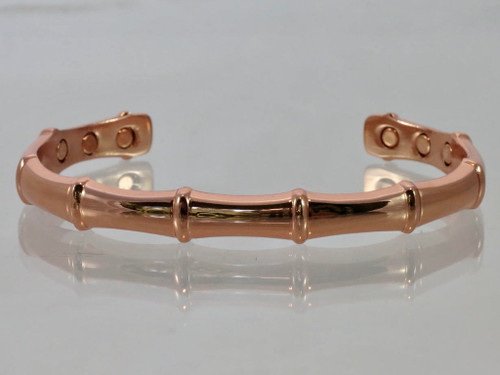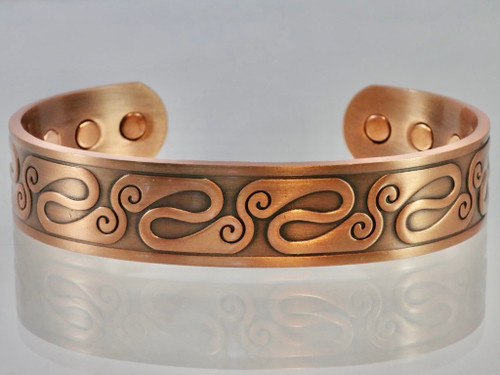-

-

Greek Key Copper Bracelet
$25.00 -

-

Copper Ring
$20.00 -

-

Copper Bracelet - Pebbles
$25.00 -

Copper Bracelet - Bamboo
$25.00 -

Copper Bracelet - Flagstaff
$25.00 -

-

-

-

Copper Bracelet
Copper Magnetic Bracelet
Revered for its curative properties, copper was widely used by ancient cultures for healing purposes. It is considered the oldest "ionizing" bracelet on our planet.
Why ancient culture used Copper Bracelets - History and Health Benefits
A sacred metal due to its believed healing properties, copper was the first metal used by early humans. The ancient Sumerians of Mesopotamia regarded the metal as sacred, associating it with the Queen of Heaven. Copper was the most popular metal in ancient Egypt as well, as ancient Egyptian artisans used copper to create various tools and weapons.
The Ankh, the symbol of life for ancient Egyptians, represents copper in hieroglyphics. The ancients knew of copper's healing qualities; they used it to treat bone injuries, wounds, and skin problems.
Cultures throughout the world have prized copper for its curative power. Arab shepherds wore copper bracelets for health reasons. Incan warriors wore copper to increase their strength and agility on the battlefield. Tibetan elders still revere copper bracelets as relics. Celtic tribes prevented rheumatism by wearing copper bracelets. In ancient China, people wore copper medical bracelets to increase their life energy, or Qi. Ancient Greeks wore copper bracelets for arthritis management, as well as to provide comfort from body aches. In India, copper is still used as drinking vessels and worn for medicinal purposes.
Copper Bracelet Benefits
Copper is an essential element for plants and animals. The human body contains a trace amount of copper, which supports the absorption of vitamin C and iron. A plasma protein called ceruloplasmin carries copper in the bloodstream to aid in the formation of red blood cells.
Additionally, copper is vital for the pigmentation of the eyes, skin, and hair. Melanocytes works in tandem with tyrosinase, a cuproenzyme derived from copper, to produce melanin, a polymer used for pigmentation. As a result, copper protects hair against graying. Moreover, copper preserves the color of the eyes. It also helps with the formation of protective tissues, aids in the synthesis of collagen and myelin, and defends the myelin sheath that encloses the nerve. In addition, copper helps in the production of elastin, an element of the skin that maintains its flexibility, making it less prone to wrinkles. Copper is a strong antioxidant that helps prevent premature aging.
Studies also suggest that copper eases joint discomfort. Copper absorbed through the skin may leave a green stain that is easily removed using soap and water.
Other Benefits of Copper
Known for its antimicrobial properties, copper kills bacteria by causing their outer membrane to rupture. This causes holes that leak out the cell's vital nutrients, thereby weakening it.
Copper, zinc, iron, and selenium are considered vital for the thyroid function.
Research suggests that copper helps increase the level of good cholesterol (HDL) while reducing the level of bad cholesterol (LDL). This lowers the risk of cardiovascular issues such as atherosclerosis and stroke. In addition, studies suggest an inverse relationship between the amount of copper found in blood and cholesterol levels. The lower the copper content in the bloodstream, the higher the cholesterol level, and vice versa.
Superior Magnetics' handmade magnetic copper bracelets incorporate an exceptionally strong magnet.
Reference:
http://www.health.com/health/gallery/0,,20723100,00.html
https://www.organicfacts.net/health-benefits/minerals/health-benefits-of-copper.html
